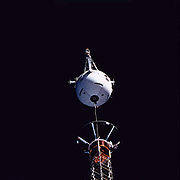
STS-75
Encyclopedia
STS-75 was a United States Space Shuttle
mission, the 19th mission of the Columbia
orbiter.
 The TSS-1R mission was a reflight of TSS-1 which was flown onboard Space Shuttle Atlantis on STS-46
The TSS-1R mission was a reflight of TSS-1 which was flown onboard Space Shuttle Atlantis on STS-46
in July/August 1992. The Tether Satellite System circled the Earth at an altitude of 296 kilometers, placing the tether system within the rarefied electrically charged layer of the atmosphere known as the ionosphere
.
STS-75 mission scientist hoped to deploy the tether to a distance of 20.7 kilometres (12.9 mi). Over 19 kilometers of the tether were deployed before the tether broke. It remained in orbit for a number of weeks and was easily visible from the ground, appearing something like a small but surprisingly bright fluorescent light traveling through the sky.
The specific TSS1-R mission objectives were: characterize the current-voltage response of the TSS-orbiter system, characterize the satellite's high-voltage sheath structure and current collection process, demonstrate electric power generation, verify tether control laws and basic tether dynamics, demonstrate the effect of neutral gas on the plasma sheath and current collection, characterize the TSS radio frequency and plasma wave emissions and characterize the TSS dynamic-electrodynamic coupling.
TSS-1R Science Investigations included: TSS Deployer Core Equipment and Satellite Core Equipment (DCORE/SCORE), Research on Orbital Plasma Electrodynamics (ROPE), Research on Electrodynamic Tether Effects (RETE), Magnetic Field Experiment for TSS Missions (TEMAG), Shuttle Electrodynamic Tether System (SETS), Shuttle Potential and Return Electron Experiment (SPREE), Tether Optical Phenomena Experiment (TOP), Investigation of Electromagnetic Emissions by the Electrodynamic Tether (EMET), Observations at the Earth's Surface of Electromagnetic Emissions by TSS (OESSE), Investigation and Measurement of Dynamic Noise in the TSS (IMDN), Theoretical and Experimental Investigation of TSS Dynamics (TEID) and the Theory and Modeling in Support of Tethered Satellite Applications (TMST).
The USMP-3 payload consisted of four major experiments mounted on two Mission Peculiar Experiment Support Structures (MPESS) and three Shuttle Mid-deck experiments. The experiments were: Advanced Automated Directional Solidification Furnace (AADSF), Material pour l'Etude des Phenomenes Interessant la Solidification sur Terre et en Orbite (MEPHISTO), Space Acceleration Measurement System (SAMS), Orbital Acceleration Research Experiment (OARE), Critical Fluid Light Scattering Experiment (ZENO) and Isothermal Dendritic Growth Experiment (IDGE).
STS-75 also was the first use of an operating system based on Linux kernel
on orbit. An older Digital Unix program, originally on DEC Alpha servers, was ported to run on Linux on a laptop. The next use of Linux was a year later, on STS-83
.
STS-75 was the shuttle mission described in the fictional NASA Document 12-571-3570
, although this document was disseminated several years before STS-75 was launched. The document purports to report on experiments to determine effective sexual positions in microgravity
. Astronomer and scientific writer Pierre Kohler mistook this document for fact and is responsible for a major increase in its redistribution in the early 21st century.
wrote an analysis of the footage giving further detail.http://www.rense.com/general/stsd.htm
Space Shuttle
The Space Shuttle was a manned orbital rocket and spacecraft system operated by NASA on 135 missions from 1981 to 2011. The system combined rocket launch, orbital spacecraft, and re-entry spaceplane with modular add-ons...
mission, the 19th mission of the Columbia
Space Shuttle Columbia
Space Shuttle Columbia was the first spaceworthy Space Shuttle in NASA's orbital fleet. First launched on the STS-1 mission, the first of the Space Shuttle program, it completed 27 missions before being destroyed during re-entry on February 1, 2003 near the end of its 28th, STS-107. All seven crew...
orbiter.
Crew
Mission parameters
- MassMassMass can be defined as a quantitive measure of the resistance an object has to change in its velocity.In physics, mass commonly refers to any of the following three properties of matter, which have been shown experimentally to be equivalent:...
: 10592 kilograms (23,351.4 lb) payload - PerigeePerigeePerigee is the point at which an object makes its closest approach to the Earth.. Often the term is used in a broader sense to define the point in an orbit where the orbiting body is closest to the body it orbits. The opposite is the apogee, the farthest or highest point.The Greek prefix "peri"...
: 277 kilometres (172.1 mi) - Apogee: 320 kilometres (198.8 mi)
- InclinationInclinationInclination in general is the angle between a reference plane and another plane or axis of direction.-Orbits:The inclination is one of the six orbital parameters describing the shape and orientation of a celestial orbit...
: 28.5° - PeriodOrbital periodThe orbital period is the time taken for a given object to make one complete orbit about another object.When mentioned without further qualification in astronomy this refers to the sidereal period of an astronomical object, which is calculated with respect to the stars.There are several kinds of...
: 90.5 min
Mission objective
The primary objective of STS-75 was to carry the Tethered Satellite System Reflight (TSS-1R) into orbit and to deploy it spaceward on a conducting tether. The mission also flew the United States Microgravity Payload (USMP-3) designed to investigate materials science and condensed matter physics.
STS-46
STS-46 was a NASA space shuttle mission using orbiter Atlantis and launched on 31 July 1992 at 9:56:48 am EDT.-Crew:-Mission parameters:*Mass:**Orbiter landing with payload: **Payload: *Perigee: *Apogee:...
in July/August 1992. The Tether Satellite System circled the Earth at an altitude of 296 kilometers, placing the tether system within the rarefied electrically charged layer of the atmosphere known as the ionosphere
Ionosphere
The ionosphere is a part of the upper atmosphere, comprising portions of the mesosphere, thermosphere and exosphere, distinguished because it is ionized by solar radiation. It plays an important part in atmospheric electricity and forms the inner edge of the magnetosphere...
.
STS-75 mission scientist hoped to deploy the tether to a distance of 20.7 kilometres (12.9 mi). Over 19 kilometers of the tether were deployed before the tether broke. It remained in orbit for a number of weeks and was easily visible from the ground, appearing something like a small but surprisingly bright fluorescent light traveling through the sky.
The specific TSS1-R mission objectives were: characterize the current-voltage response of the TSS-orbiter system, characterize the satellite's high-voltage sheath structure and current collection process, demonstrate electric power generation, verify tether control laws and basic tether dynamics, demonstrate the effect of neutral gas on the plasma sheath and current collection, characterize the TSS radio frequency and plasma wave emissions and characterize the TSS dynamic-electrodynamic coupling.
TSS-1R Science Investigations included: TSS Deployer Core Equipment and Satellite Core Equipment (DCORE/SCORE), Research on Orbital Plasma Electrodynamics (ROPE), Research on Electrodynamic Tether Effects (RETE), Magnetic Field Experiment for TSS Missions (TEMAG), Shuttle Electrodynamic Tether System (SETS), Shuttle Potential and Return Electron Experiment (SPREE), Tether Optical Phenomena Experiment (TOP), Investigation of Electromagnetic Emissions by the Electrodynamic Tether (EMET), Observations at the Earth's Surface of Electromagnetic Emissions by TSS (OESSE), Investigation and Measurement of Dynamic Noise in the TSS (IMDN), Theoretical and Experimental Investigation of TSS Dynamics (TEID) and the Theory and Modeling in Support of Tethered Satellite Applications (TMST).
The USMP-3 payload consisted of four major experiments mounted on two Mission Peculiar Experiment Support Structures (MPESS) and three Shuttle Mid-deck experiments. The experiments were: Advanced Automated Directional Solidification Furnace (AADSF), Material pour l'Etude des Phenomenes Interessant la Solidification sur Terre et en Orbite (MEPHISTO), Space Acceleration Measurement System (SAMS), Orbital Acceleration Research Experiment (OARE), Critical Fluid Light Scattering Experiment (ZENO) and Isothermal Dendritic Growth Experiment (IDGE).
STS-75 also was the first use of an operating system based on Linux kernel
Linux kernel
The Linux kernel is an operating system kernel used by the Linux family of Unix-like operating systems. It is one of the most prominent examples of free and open source software....
on orbit. An older Digital Unix program, originally on DEC Alpha servers, was ported to run on Linux on a laptop. The next use of Linux was a year later, on STS-83
STS-83
STS-83 was a mission of the United States Space Shuttle Columbia.-Crew:-Mission parameters:*Mass:**Orbiter Landing with payload: **MSL-1 Spacelab Module: *Perigee: *Apogee: *Inclination: 28.5°...
.
STS-75 was the shuttle mission described in the fictional NASA Document 12-571-3570
Document 12-571-3570
Document 12-571-3570 is a hoax document originally posted to the Usenet newsgroup alt.sex on November 28, 1989. According to this document, astronauts aboard space shuttle mission STS-75 performed a variety of sex acts to determine which positions are most effective in zero gravity...
, although this document was disseminated several years before STS-75 was launched. The document purports to report on experiments to determine effective sexual positions in microgravity
Sex in space
Sex in space refers to sexual activity in the weightlessness and/or extreme environments of outer space. Usually only human sexual activity is considered...
. Astronomer and scientific writer Pierre Kohler mistook this document for fact and is responsible for a major increase in its redistribution in the early 21st century.
"UFO" incident
Excerpts of video footage shot from STS-75 have been widely circulated by UFO enthusiasts, who believe that visual anomalies in the footage represent an unexplained paranormal phenomenon.http://www.youtube.com/watch?v=JuFBUS0kiSA The STS-75 crew identified the "UFOs" as small particles of debris filmed out of focus. Space journalist James ObergJames Oberg
James Edward Oberg is an American space journalist and historian, regarded as an expert on the Russian space program.-Biography:...
wrote an analysis of the footage giving further detail.http://www.rense.com/general/stsd.htm

